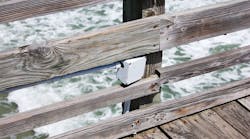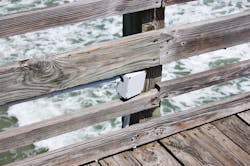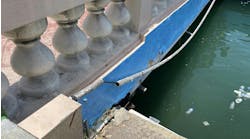Hint: PVC problems on the pier
Scroll Down to See the Answer
It won’t be long now before water starts to get into this box and wreak havoc with any terminations or splices that may be inside. The gaping hole created by the PVC popping out of the box can also allow all kinds of critters like bees and wasps to make a happy home inside the box, creating a wonderful surprise for the poor electrician who opens it while troubleshooting to see why the power is out. I’ve been the unlucky recipient of that surprise a few times in my career. It’s not fun.
Properly securing the PVC and the box could help prevent situations like this from happening. This ¾-in. PVC conduit is required to be securely fastened within 3 ft of this box as specified in Sec. 352.30(A). As you can see, there are no clips visible in this photo. Perhaps using an expansion/deflection fitting on the PVC conduit as specified in Sec. 300.7(B) and Sec. 352.44 could have helped maintain the integrity of this installation. What we have now is a violation of Sec. 314.17(C), which requires the PVC wiring method to be secured to the box.
In addition, we also have a violation of Sec. 300.12, which requires raceways to be continuous between boxes and other enclosures. This one now comes up a little short.





